Minerals of Rare Earth Elements in High-Phosphorus Ooidal Ironstones of the Western Siberia and Turgai Depression
Abstract
1. Introduction
2. Materials and Methods
2.1. Studied Areas
2.1.1. Upper Cretaceous–Lower Paleogene Bakchar Deposit
2.1.2. Middle Oligocene Lisakovsk Deposit
2.2. Methods
3. Results
4. Discussion
5. Conclusions
Author Contributions
Funding
Acknowledgments
Conflicts of Interest
References
- Petranek, J.; Van Houten, F.B. Phanerozoic Ooidal Ironstones. Czech Geol. Surv. Spec. Pap. 1997, 7, 4–71. [Google Scholar]
- Van Houten, F.B.; Bhattacharyya, D.P. Phanerozoic Oolitic Ironstones—Geologic Record and Facies Model. Annu. Rev. Earth Planet. Sci. 1982, 10, 441–457. [Google Scholar] [CrossRef]
- Young, T.P. Phanerozoic ironstones: An introduction and review. Geol. Soc. Lond. Spec. Publ. 1989, 46, ix–xxv. [Google Scholar] [CrossRef]
- Sturesson, U. Lower Palaeozoic iron oolites and volcanism from a Baltoscandian perspective. Sediment. Geol. 2003, 159, 241–256. [Google Scholar] [CrossRef]
- Heikoop, J.M.; Tsujita, C.J.; Risk, M.J.; Tomascik, T.; Mah, A.J. Modern iron ooids from a shallow-marine volcanic setting: Mahengetang, Indonesia. Geology 1996, 24, 759–762. [Google Scholar] [CrossRef]
- Kimberley, M.M. Debate about ironstone: Has solute supply been surficial weathering, hydrothermal convection, or exhalation of deep fluids? Terra Nova 1994, 6, 116–132. [Google Scholar] [CrossRef]
- Di Bella, M.; Sabatino, G.; Quartieri, S.; Ferretti, A.; Cavalazzi, B.; Barbieri, R.; Foucher, F.; Messori, F.; Italiano, F. Modern Iron Ooids of Hydrothermal Origin as a Proxy for Ancient Deposits. Sci. Rep. 2019, 9, 7107. [Google Scholar] [CrossRef] [PubMed]
- Ramanaidou, E.R.; Wells, M.A. 13.13—Sedimentary Hosted Iron Ores. In Treatise on Geochemistry; Newnes: London, UK, 2014; pp. 313–355. ISBN 9780080983004. [Google Scholar]
- Bekker, A.; Planavsky, N.J.; Krapež, B.; Rasmussen, B.; Hofmann, A.; Slack, J.F.; Rouxel, O.J.; Konhauser, K.O. 9.18—Iron Formations: Their Origins and Implications for Ancient Seawater Chemistry. In Treatise on Geochemistry; Newnes: London, UK, 2014; pp. 561–628. ISBN 9780080983004. [Google Scholar]
- Kimberley, M.M. Origin of Oolitic Iron Formations. SEPM J. Sediment. Res. 1979, 49, 111–131. [Google Scholar]
- Kimberley, M.M. Exhalative origins of iron formations. Ore Geol. Rev. 1989, 5, 13–145. [Google Scholar] [CrossRef]
- Van Houten, F.B.; Hou, H.F. Stratigraphic and palaeogeographic distribution of Palaeozoic oolitic ironstones. Geol. Soc. Mem. 1990, 12, 87–93. [Google Scholar] [CrossRef]
- Kholodov, V.N.; Golubovskaya, E.V.; Nedumov, R.I. Origin and prospects of the Cimmerian iron ore basin in Ukraine and Russia. Lithol. Miner. Resour. 2014, 49, 359–380. [Google Scholar] [CrossRef]
- Strakhov, N.M. Iron Ore Facies and Their Analogues in the Earth’s History: Experience of Historical-Geographical Analysis of Sedimentary Processes. Tr. IGN SSSR. Geol. Ser. 1947, 22, 261–267. [Google Scholar]
- Dreesen, R. Oolitic ironstones as event-stratigraphical marker beds within the Upper Devonian of the Ardenno-Rhenish Massif. Geol. Soc. Lond. Spec. Publ. 1989, 46, 65–78. [Google Scholar] [CrossRef]
- Mücke, A.; Farshad, F. Whole-rock and mineralogical composition of Phanerozoic ooidal ironstones: Comparison and differentiation of types and subtypes. Ore Geol. Rev. 2005, 26, 227–262. [Google Scholar] [CrossRef]
- Mücke, A. Chamosite, siderite and the environmental conditions of their formation in chamosite-type Phanerozoic ooidal ironstones. Ore Geol. Rev. 2006, 28, 235–249. [Google Scholar] [CrossRef]
- Garnit, H.; Bouhlel, S. Petrography, mineralogy and geochemistry of the Late Eocene oolitic ironstones of the Jebel Ank, Southern Tunisian Atlas. Ore Geol. Rev. 2017, 84, 134–153. [Google Scholar] [CrossRef]
- Afify, A.M.; Sanz-Montero, M.E.; Calvo, J.P. Differentiation of ironstone types by using rare earth elements and yttrium geochemistry—A case study from the Bahariya region, Egypt. Ore Geol. Rev. 2018, 96, 247–261. [Google Scholar] [CrossRef]
- Baioumy, H.; Omran, M.; Fabritius, T. Mineralogy, geochemistry and the origin of high-phosphorus oolitic iron ores of Aswan, Egypt. Ore Geol. Rev. 2017, 80, 185–199. [Google Scholar] [CrossRef]
- Burkhalter, R.M. Ooidal ironstones and ferruginous microbialites: Origin and relation to sequence stratigraphy (Aalenian and Bajocian, Swiss Jura mountains). Sedimentology 1995, 42, 57–74. [Google Scholar] [CrossRef]
- Kholodov, V.N.; Nedumov, R.I.; Golubovskaya, E.V. Facies types of sedimentary iron ore deposits and their geochemical features: Communication 2. Problems of the geochemistry of phanerozoic iron ores. Lithol. Miner. Resour. 2013, 48, 14–47. [Google Scholar] [CrossRef]
- Maynard, J.B. Geochemistry of oolitic iron ores, an electron microprobe study. Econ. Geol. 1986, 81, 1473–1483. [Google Scholar] [CrossRef]
- Mücke, A. Part II. Postdiagenetic Ferruginization of Phanerozoic (oolitic) Ironstones: A Contribution to Their Geneses. Dev. Sedimentol. 1994, 51, 396–423. [Google Scholar]
- Mücke, A. Environmental conditions in the Late Cretaceous African Tethys: Conclusions from a microscopic-microchemical study of ooidal ironstones from Egypt, Sudan and Nigeria. J. Afr. Earth Sci. 2000, 30, 25–46. [Google Scholar] [CrossRef]
- Taylor, W.E.G. Sedimentary Rocks | Ironstones. In Encyclopedia of Geology; Academic Press: Cambridge, MA, USA, 2005; pp. 97–107. ISBN 9780123693969. [Google Scholar]
- Salama, W.; El Aref, M.M.; Gaupp, R. Mineral evolution and processes of ferruginous microbialite accretion—An example from the Middle Eocene stromatolitic and ooidal ironstones of the Bahariya Depression, Western Desert, Egypt. Geobiology 2013, 11, 15–28. [Google Scholar] [CrossRef] [PubMed]
- Salama, W.; El Aref, M.; Gaupp, R. Mineralogical and geochemical investigations of the Middle Eocene ironstones, El Bahariya Depression, Western Desert, Egypt. Gondwana Res. 2012, 22, 717–736. [Google Scholar] [CrossRef]
- Golubovskaya, E.V. Some geochemical features of iron ores from the Lisakov deposit. Lithol. Miner. Resour. 2003, 38, 275–281. [Google Scholar] [CrossRef]
- Taylor, K.G.; Konhauser, K.O. Iron in Earth Surface Systems: A Major Player in Chemical and Biological Processes. Elements 2011, 7, 83–88. [Google Scholar] [CrossRef]
- Golubovskaya, E.V. Facies and geochemical features of the iron ore complex of the Kerch Peninsula. Lithol. Miner. Resour. 2001, 36, 224–235. [Google Scholar] [CrossRef]
- Zitzmann, E.A. The Iron Ore Deposits of Europe and Adjacent Areas = Explan. Notes to the International Map of Iron Ore Deposits in Europe 1:2 500000; Schweizerbart Science Publishers: Stuttgart, Germany, 1978; ISBN 9783510967193. [Google Scholar]
- Konhauser, K.O. Diversity of bacterial iron mineralization. Earth-Sci. Rev. 1998, 43, 91–121. [Google Scholar] [CrossRef]
- Novoselov, K.A.; Belogub, E.V.; Kotlyarov, V.A.; Filippova, K.A.; Sadykov, S.A. Mineralogical and Geochemical Features of Oolitic Ironstones from the Sinara–Techa Deposit, Kurgan District, Russia. Geol. Ore Depos. 2018, 60, 265–276. [Google Scholar] [CrossRef]
- Rudmin, M.; Mazurov, A.; Banerjee, S. Origin of ooidal ironstones in relation to warming events: Cretaceous-Eocene Bakchar deposit, south-east Western Siberia. Mar. Pet. Geol. 2019, 100, 309–325. [Google Scholar] [CrossRef]
- Rudmin, M.A.; Mazurov, A.K. Oolitic ores in the Bakchar iron-ore cluster (Tomsk Oblast). Dokl. Earth Sci. 2016, 471, 1238–1241. [Google Scholar] [CrossRef]
- Rasmussen, B.; Buick, R.; Taylor, W.R. Removal of oceanic REE by authigenic precipitation of phosphatic minerals. Earth Planet. Sci. Lett. 1998, 164, 135–149. [Google Scholar] [CrossRef]
- Rasmussen, B. Early-diagenetic REE-phosphate minerals (florencite, gorceixite, crandallite, and xenotime) in marine sandstones: A major sink for oceanic phosphorus. Am. J. Sci. 1996, 296, 601–632. [Google Scholar] [CrossRef]
- Rasmussen, B. Radiometric dating of sedimentary rocks: The application of diagenetic xenotime geochronology. Earth-Sci. Rev. 2005, 68, 197–243. [Google Scholar] [CrossRef]
- Marino, E.; González, F.J.; Kuhn, T.; Madureira, P.; Wegorzewski, A.V.; Mirao, J.; Medialdea, T.; Oeser, M.; Miguel, C.; Reyes, J.; et al. Hydrogenetic, Diagenetic and Hydrothermal Processes Forming Ferromanganese Crusts in the Canary Island Seamounts and Their Influence in the Metal Recovery Rate with Hydrometallurgical Methods. Minerals 2019, 9, 439. [Google Scholar] [CrossRef]
- Gamaletsos, P.N.; Godelitsas, A.; Filippidis, A.; Pontikes, Y. The Rare Earth Elements Potential of Greek Bauxite Active Mines in the Light of a Sustainable REE Demand. J. Sustain. Metall. 2019, 5, 20–47. [Google Scholar] [CrossRef]
- Hartmann, B.T.; Gaupp, R.; Oberhaensli, R. Authigenic rare earth fluorocarbonates (synchiste) in Rotliegend sandstone from the North-German Basin: Constraints for REE mobility during diagenesis. Gaea Heidelb. 1997, 3, 158. [Google Scholar]
- Krishnamurthy, N.; Gupta, C.K.; Gupta, C.K. Extractive Metallurgy of Rare Earths; CRC Press: Boca Raton, FL, USA, 2015; ISBN 9780429100987. [Google Scholar]
- Dutrizac, J.E.; Soriano, C. Behaviour of the rare earths during goethite (α-FeOOH) precipitation from sulphate-based solutions. Hydrometallurgy 2018, 176, 87–96. [Google Scholar] [CrossRef]
- Baioumy, H.M. Iron–phosphorus relationship in the iron and phosphorite ores of Egypt. Chem. Erde Geochem. 2007, 67, 229–239. [Google Scholar] [CrossRef]
- Wang, J.; Shen, S.; Kang, J.; Li, H.; Guo, Z. Effect of ore solid concentration on the bioleaching of phosphorus from high-phosphorus iron ores using indigenous sulfur-oxidizing bacteria from municipal wastewater. Process Biochem. 2010, 45, 1624–1631. [Google Scholar] [CrossRef]
- Belous, N.C.; Nikolaeva, I.V.; Kazansky, Y.P.; Berdnikov, A.P.; Klyarovskiy, V.M.; Kuznetsov, V.P.; Babin, A.A. The Western-Siberian Iron Ore Basin; Siberian Branch of the Academy of Sciences of the USSR: Novosibirsk, Russia, 1964. [Google Scholar]
- Podobina, V.M.; Kseneva, T.G. Upper Cretaceous zonal stratigraphy of the West Siberian Plain based on foraminifera. Cretac. Res. 2005, 26, 133–143. [Google Scholar] [CrossRef]
- Podobina, V.M. Substantiation of the Paleocene-Eocene boundary in western Siberia by foraminifers. Stratigr. Geol. Correl. 1998, 6, 142–149. [Google Scholar]
- Lebedeva, N.K.; Kuzmina, O.B.; Sobolev, E.S.; Khazina, I.V. Stratigraphy of Upper Cretaceous and Cenozoic deposits of the Bakchar iron ore deposit (southwestern Siberia): New data. Stratigr. Geol. Correl. 2017, 25, 76–98. [Google Scholar] [CrossRef]
- Lebedeva, N.K.; Aleksandrova, G.N.; Shurygin, B.N.; Ovechkina, M.N.; Gnibidenko, Z.N. Paleontological and magnetostratigraphic data on Upper Cretaceous deposits from borehole no. 8 (Russkaya Polyana District, Southwestern Siberia). Stratigr. Geol. Correl. 2013, 21, 48–78. [Google Scholar] [CrossRef]
- Gnibidenko, Z.N.; Lebedeva, N.K.; Levicheva, A.V. Magnetostratigraphy of the Campanian–Maastrichtian Bakchar Basin (southeastern West Siberia). Russ. Geol. Geophys. 2015, 56, 1652–1661. [Google Scholar] [CrossRef]
- Nikolaeva, I.V. Bakchar Oolitic Iron Ore Deposit; Siberian Branch of the Academy of Sciences of the USSR: Novosibirsk, Russia, 1967. [Google Scholar]
- Kontorovich, A.E.; Ershov, S.V.; Kazanenkov, V.A.; Karogodin, Y.N.; Kontorovich, V.A.; Lebedeva, N.K.; Nikitenko, B.L.; Popova, N.I.; Shurygin, B.N. Cretaceous paleogeography of the West Siberian sedimentary basin. Russ. Geol. Geophys. 2014, 55, 582–609. [Google Scholar] [CrossRef]
- Smith, A.G.; Smith, D.G.; Funnell, B.M. Atlas of Mesozoic and Cenozoic Coastlines; Cambridge University Press: Cambridge, UK, 1994; ISBN 0521451558. [Google Scholar]
- Hooker, J.J.; Dashzeveg, D. Evidence for Direct Mammalian Faunal Interchange between Europe and Asia near the Paleocene-Eocene Boundary; Geoscience World: McLean, VA, USA, 2003; Volume 369. [Google Scholar]
- Iakovleva, A.I.; Brinkhuis, H.; Cavagnetto, C. Late Palaeocene–Early Eocene dinoflagellate cysts from the Turgay Strait, Kazakhstan; correlations across ancient seaways. Palaeogeogr. Palaeoclimatol. Palaeoecol. 2001, 172, 243–268. [Google Scholar] [CrossRef]
- Vibe, Y.; Bunge, H.P.; Clark, S.R. Anomalous subsidence history of the West Siberian Basin as an indicator for episodes of mantle induced dynamic topography. Gondwana Res. 2018, 53, 99–109. [Google Scholar] [CrossRef]
- Gehring, A.U. The formation of goethitic ooids in condensed Jurassic deposits in northern Switzerland. Geol. Soc. Spec. Publ. 1989, 46, 133–139. [Google Scholar] [CrossRef]
- Rudmin, M.; Roberts, A.P.; Horng, C.S.; Mazurov, A.; Savinova, O.; Ruban, A.; Kashapov, R.; Veklich, M. Ferrimagnetic Iron Sulfide Formation and Methane Venting Across the Paleocene-Eocene Thermal Maximum in Shallow Marine Sediments, Ancient West Siberian Sea. Geochem. Geophys. Geosyst. 2018, 19, 1–22. [Google Scholar] [CrossRef]
- Yanickiy, A.L. Oligocene Oolitic Iron Ores of Northern Turgai and Its Genesis; AN USSR: Moscow, Russia, 1960. (In Russia) [Google Scholar]
- Slipchenko, B.V. About two genetic types of oolitic iron ores of the Lisakovsk deposit (Northern Kazakhstan). Russ. Geol. J. 1981, 41, 53–61. (In Russia) [Google Scholar]
- Baele, J.-M.; Dreesen, R.; Dusar, M. Assessing apatite cathodoluminescence as a tool for sourcing oolitic ironstones. Anthropol. Praehist. 2015, 126, 57–67. [Google Scholar]
- Rudmin, M.A.; Mazurov, A.K.; Reva, I.V. Mineral microinclusions in glauconite of bakchar deposit (tomsk region). Bull. Tomsk Polytech. Univ. Geo. Assets Eng. 2016, 327, 54–64. [Google Scholar]
- Rudmin, M.; Banerjee, S.; Mazurov, A. Compositional variation of glauconites in Upper Cretaceous-Paleogene sedimentary iron-ore deposits in South-eastern Western Siberia. Sediment. Geol. 2017, 355, 20–30. [Google Scholar] [CrossRef]
- Hughes, C.R. The application of analytical transmission electron microscopy to the study of oolitic ironstones: A preliminary study. Geol. Soc. Lond. Spec. Publ. 1989, 46, 121–131. [Google Scholar] [CrossRef]
- Burnotte, E.; Pirard, E.; Michel, G. Genesis of gray monazites: Evidence from the Paleozoic of Belgium. Econ. Geol. 1989, 84, 1417–1429. [Google Scholar] [CrossRef]
- Alipour-Asll, M.; Mirnejad, H.; Milodowski, A.E. Occurrence and paragenesis of diagenetic monazite in the upper Triassic black shales of the Marvast region, South Yazd, Iran. Mineral. Petrol. 2012, 104, 197–210. [Google Scholar] [CrossRef]
- Halpin, J.A.; Jensen, T.; McGoldrick, P.; Meffre, S.; Berry, R.F.; Everard, J.L.; Calver, C.R.; Thompson, J.; Goemann, K.; Whittaker, J.M. Authigenic monazite and detrital zircon dating from the Proterozoic Rocky Cape Group, Tasmania: Links to the Belt-Purcell Supergroup, North America. Precambrian Res. 2014, 250, 50–67. [Google Scholar] [CrossRef]
- Auer, G.; Reuter, M.; Hauzenberger, C.A.; Piller, W.E. The impact of transport processes on rare earth element patterns in marine authigenic and biogenic phosphates. Geochim. Cosmochim. Acta 2017, 203, 140–156. [Google Scholar] [CrossRef]
- Alibert, C. Rare earth elements in Hamersley BIF minerals. Geochim. Cosmochim. Acta 2016, 184, 311–328. [Google Scholar] [CrossRef]
- Bern, C.R.; Shah, A.K.; Benzel, W.M.; Lowers, H.A. The distribution and composition of REE-bearing minerals in placers of the Atlantic and Gulf coastal plains, USA. J. Geochem. Explor. 2016, 162, 50–61. [Google Scholar] [CrossRef]
- Lazareva, E.V.; Zhmodik, S.M.; Prokopiev, A.V.; Karmanov, N.S.; Sergeenko, A.I. Nodular monazite from placers in the Kular Ridge (Arctic Siberia, Russia): Composition and age. Russ. Geol. Geophys. 2018, 59, 1330–1347. [Google Scholar] [CrossRef]
- Barale, L.; D’atri, A.; Martire, L. The Role of Microbial Activity In the Generation of Lower Cretaceous Mixed FE-Oxide-phosphate Ooids from the Provencal Domain, French Maritime Alps. J. Sediment. Res. 2013, 83, 196–206. [Google Scholar] [CrossRef]
- Berner, R.A. Goethite stability and the origin of red beds. Geochim. Cosmochim. Acta 1969, 33, 267–273. [Google Scholar] [CrossRef]
- Berger, A.; Janots, E.; Gnos, E.; Frei, R.; Bernier, F. Rare earth element mineralogy and geochemistry in a laterite profile from Madagascar. Appl. Geochem. 2014, 41, 218–228. [Google Scholar] [CrossRef]
- Bau, M.; Schmidt, K.; Koschinsky, A.; Hein, J.; Kuhn, T.; Usui, A. Discriminating between different genetic types of marine ferro-manganese crusts and nodules based on rare earth elements and yttrium. Chem. Geol. 2014, 381, 1–9. [Google Scholar] [CrossRef]
- Bau, M.; Koschinsky, A. Oxidative scavenging of cerium on hydrous Fe oxide: Evidence from the distribution of rare earth elements and yttrium between Fe oxides and Mn oxides in hydrogenetic ferromanganese crusts. Geochem. J. 2009, 43, 37–47. [Google Scholar] [CrossRef]
- Pufahl, P.K.; Hiatt, E.E. Oxygenation of the Earth’s atmosphere–ocean system: A review of physical and chemical sedimentologic responses. Mar. Pet. Geol. 2012, 32, 1–20. [Google Scholar] [CrossRef]
- Sturesson, U. Llanvirnian (Ord.) iron ooids in Baltoscandia: Element mobility, REE distribution patterns, and origin of the REE. Chem. Geol. 1995, 125, 45–60. [Google Scholar] [CrossRef]
- Kryza, R.; Zalasiewicz, J.A.; Charnley, N.; Milodowski, A.E.; Kostylew, J.; Tyszka, R. In situ growth of monazite in anchizonal to epizonal mudrocks: First record from the Variscan accretionary prism of the Kaczawa Mountains, West Sudetes, SW Poland. Geol. Sudet. 2004, 36, 39–51. [Google Scholar]
- El-Habaak, G.; Askalany, M.; Abdel-Hakeem, M. Possibility of Mixed Origin of Rare Earth Elements in Sedimentary Marine Apatites: A Case Study from Phosphorites in the Cretaceous (Campanian-Maastrichtian) Duwi Formation, Abu-Tartur Plateau, Egypt. J. Geol. 2019, 127, 643–663. [Google Scholar] [CrossRef]
- Baioumy, H. Rare earth elements and sulfur and strontium isotopes of upper Cretaceous phosphorites in Egypt. Cretac. Res. 2011, 32, 368–377. [Google Scholar] [CrossRef]
- Kechiched, R.; Laouar, R.; Bruguier, O.; Laouar-Salmi, S.; Ameur-Zaimeche, O.; Foufou, A. Preliminary Data of REE in Algerian Phosphorites: A Comparative Study and Paleo-redox Insights. Procedia Eng. 2016, 138, 19–29. [Google Scholar] [CrossRef]
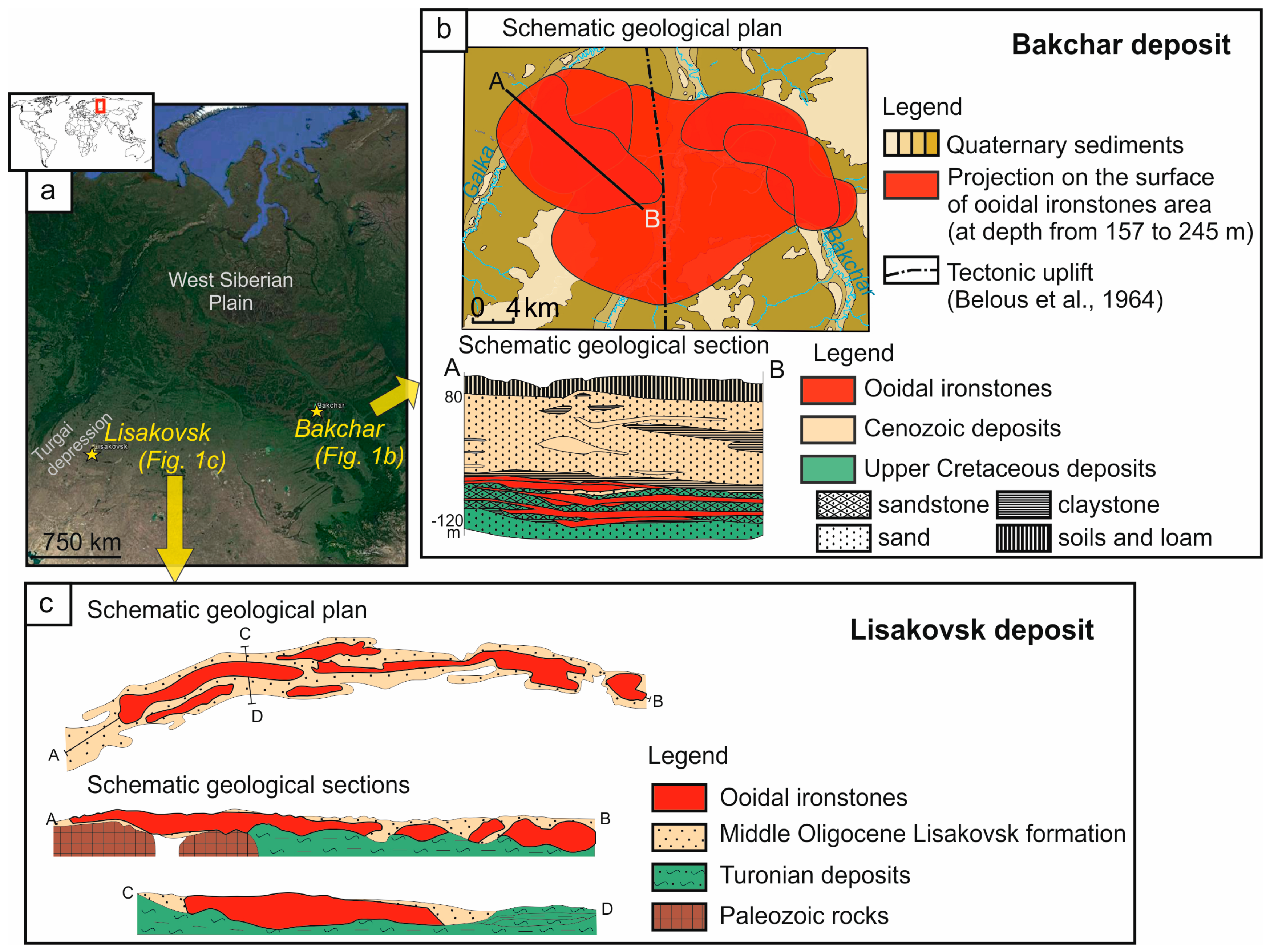
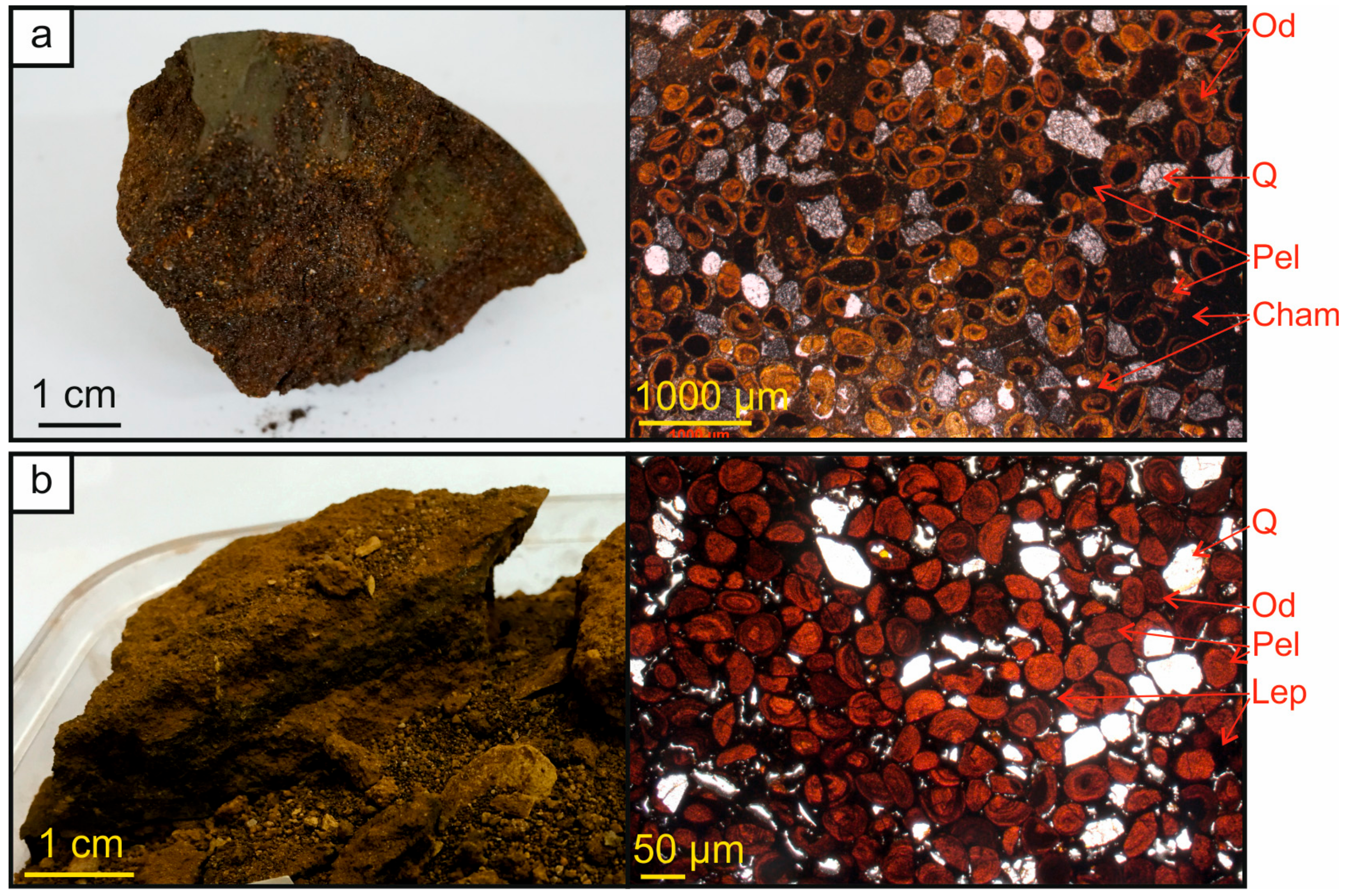
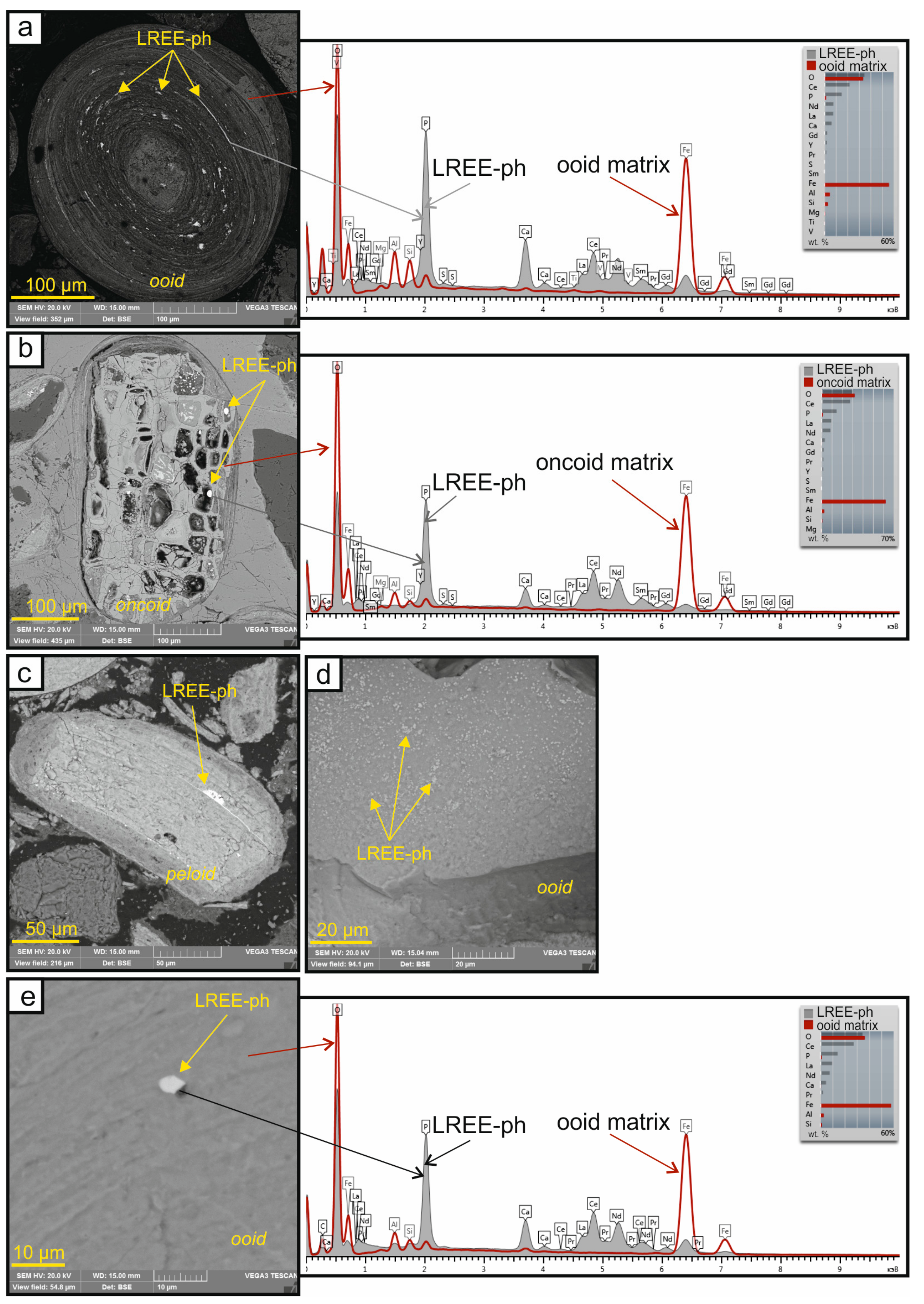
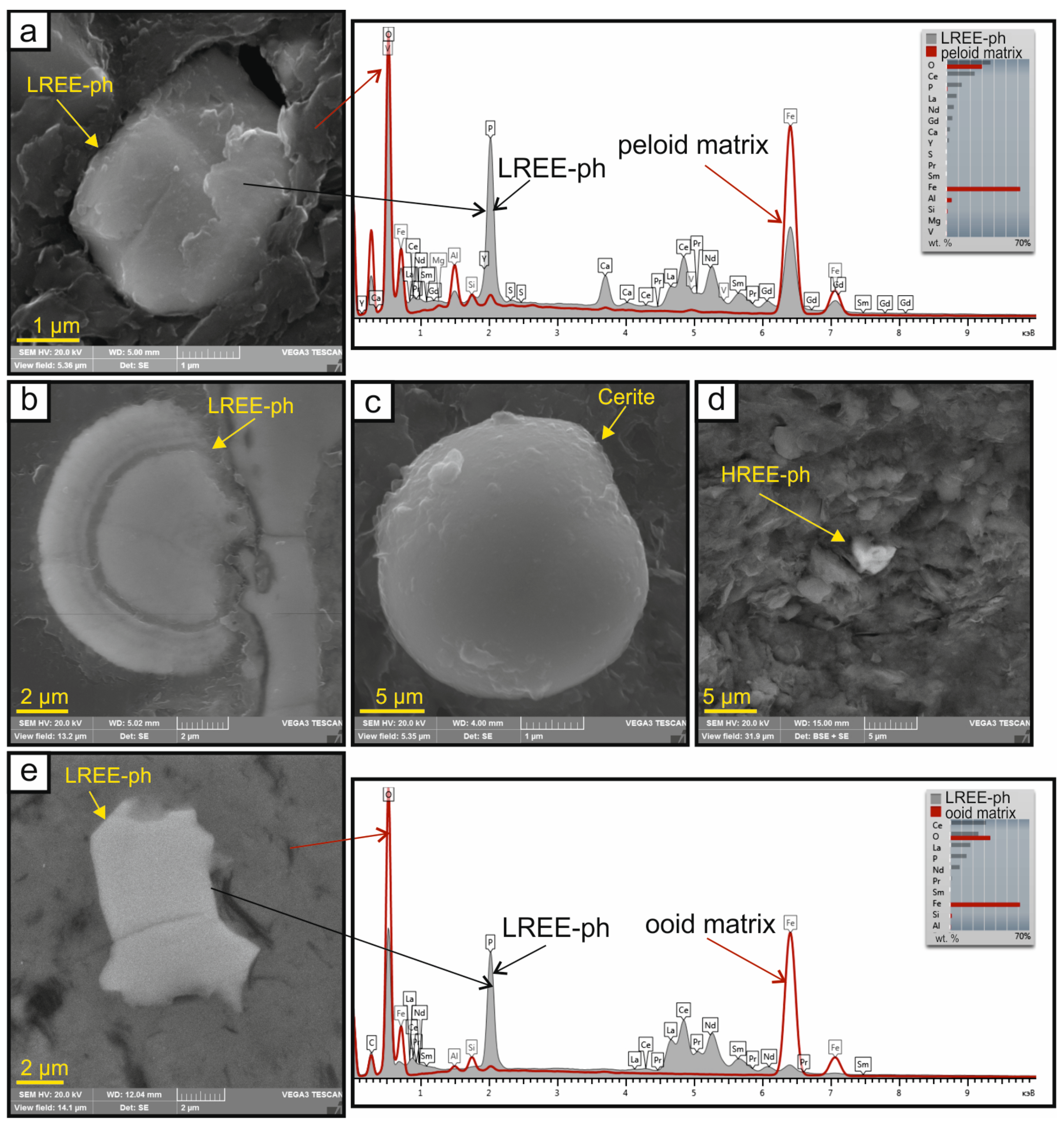
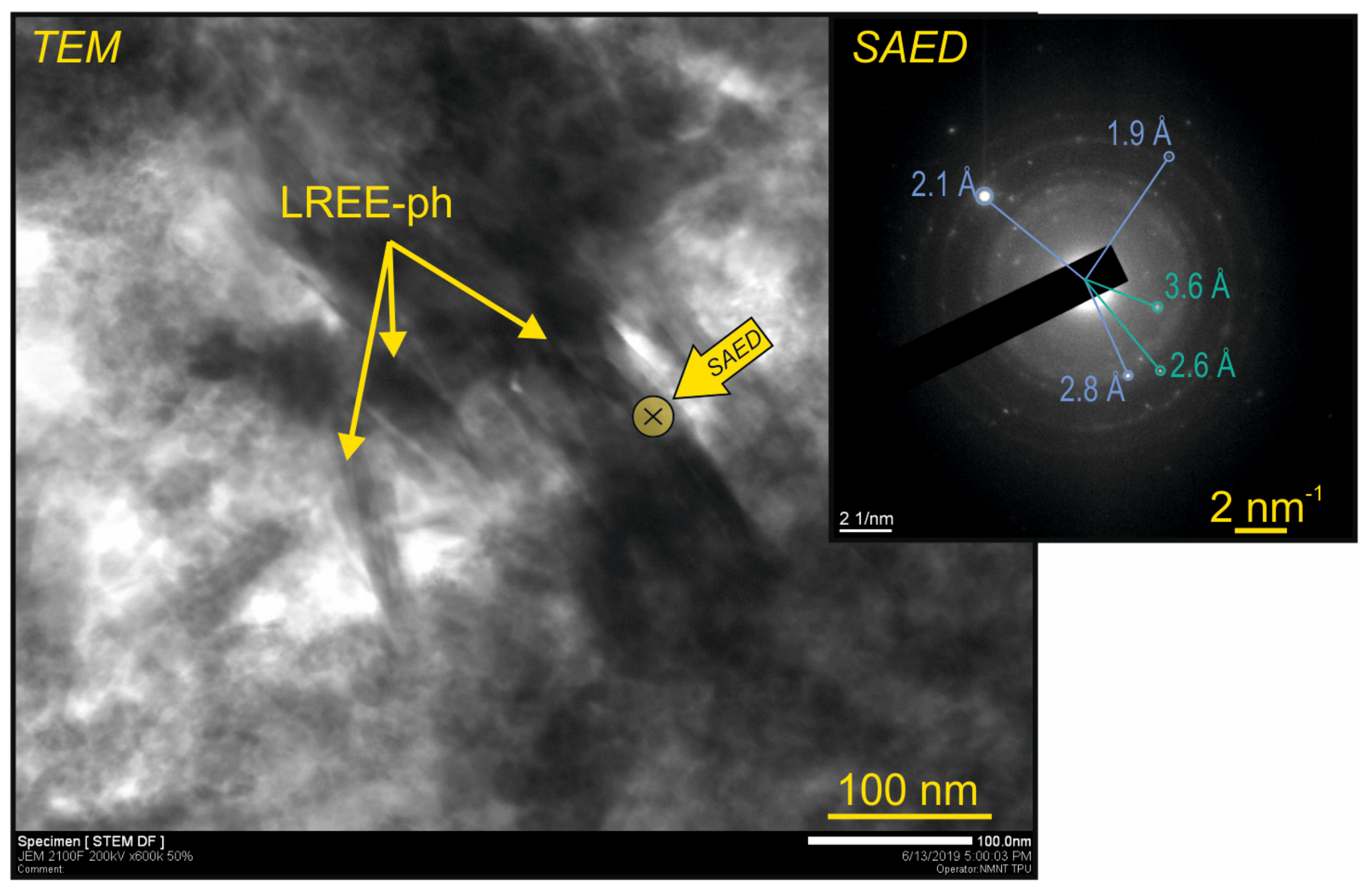

| Deposit | P2O5 | CaO | Fe2O3 | Y2O3 | La2O3 | Ce2O3 | Pr2O3 | Nd2O3 | Sm2O3 | Gd2O3 | ThO2 | Total | |
|---|---|---|---|---|---|---|---|---|---|---|---|---|---|
| Authigenic LREE-phosphate | |||||||||||||
| Bakchar | 28.4 | 1.1 | 14.3 | 29.4 | 3.1 | 12.5 | 2.6 | 1.5 | 92.8 | ||||
| Bakchar | 30.9 | 4.3 | 5.0 | 10.2 | 26.4 | 2.3 | 9.9 | 1.8 | 90.7 | ||||
| Bakchar | 30.4 | 4.1 | 3.0 | 2.1 | 9.9 | 28.7 | 2.6 | 9.7 | 2.2 | 1.8 | 95.1 | ||
| Bakchar | 47.8 | 8.9 | 10.6 | 22.9 | 9.9 | 100.0 | |||||||
| Bakchar | 30.9 | 5.9 | 5.7 | 9.7 | 24.0 | 2.5 | 9.4 | 1.5 | 1.0 | 90.6 | |||
| Bakchar | 29.1 | 1.6 | 2.3 | 13.3 | 27.3 | 3.3 | 14.4 | 2.9 | 94.2 | ||||
| Bakchar | 33.2 | 6.2 | 10.9 | 2.5 | 8.8 | 21.2 | 2.3 | 9.0 | 1.7 | 1.6 | 97.5 | ||
| Bakchar | 33.0 | 0.5 | 15.6 | 31.9 | 2.8 | 9.7 | 93.5 | ||||||
| Bakchar | 25.6 | 0.4 | 1.6 | 11.7 | 27.7 | 2.9 | 10.9 | 2.3 | 1.1 | 84.3 | |||
| Bakchar | 30.0 | 7.5 | 7.6 | 2.5 | 7.6 | 21.2 | 2.6 | 9.0 | 1.7 | 1.2 | 90.8 | ||
| Bakchar | 42.0 | 8.8 | 30.5 | 2.7 | 10.6 | 94.5 | |||||||
| Bakchar | 29.0 | 0.7 | 1.1 | 17.7 | 30.9 | 8.5 | 87.8 | ||||||
| Bakchar | 36.9 | 14.4 | 8.9 | 28.2 | 8.2 | 100.0 | |||||||
| Bakchar | 42.2 | 9.7 | 9.6 | 26.7 | 8.7 | 100.0 | |||||||
| Bakchar | 37.7 | 11.1 | 2.2 | 10.8 | 26.4 | 9.5 | 100.0 | ||||||
| Bakchar | 41.1 | 11.2 | 10.1 | 26.3 | 8.8 | 100.0 | |||||||
| Bakchar | 36.7 | 12.0 | 10.2 | 30.9 | 7.9 | 100.0 | |||||||
| Bakchar | 38.3 | 13.4 | 9.6 | 26.7 | 8.6 | 100.0 | |||||||
| Bakchar | 41.8 | 12.1 | 10.0 | 24.9 | 7.6 | 96.5 | |||||||
| Bakchar | 28.3 | 0.4 | 6.3 | 30.4 | 4.2 | 14.0 | 2.4 | 2.3 | 90.5 | ||||
| Bakchar | 29.6 | 0.6 | 1.6 | 13.6 | 30.2 | 3.7 | 14.2 | 2.5 | 95.9 | ||||
| Bakchar | 35.1 | 0.8 | 1.3 | 13.4 | 30.9 | 3.1 | 13.0 | 97.7 | |||||
| Bakchar | 26.7 | 4.0 | 1.2 | 1.3 | 15.2 | 18.6 | 3.5 | 13.4 | 2.7 | 1.0 | 87.4 | ||
| Bakchar | 30.7 | 5.4 | 1.7 | 13.1 | 26.9 | 3.5 | 10.8 | 92.1 | |||||
| Bakchar | 31.5 | 5.5 | 4.2 | 8.4 | 23.6 | 2.3 | 9.7 | 85.2 | |||||
| Lisakovsk | 29.9 | 4.3 | 18.7 | 32.5 | 2.7 | 9.9 | 1.9 | 100.0 | |||||
| Lisakovsk | 35.9 | 7.0 | 13.4 | 33.6 | 10.2 | 100.0 | |||||||
| Lisakovsk | 35.0 | 7.0 | 12.0 | 34.0 | 2.6 | 9.5 | 100.0 | ||||||
| Lisakovsk | 39.9 | 7.4 | 10.8 | 32.7 | 9.2 | 100.0 | |||||||
| Lisakovsk | 39.6 | 7.8 | 12.0 | 32.7 | 8.0 | 100.0 | |||||||
| Lisakovsk | 36.3 | 6.8 | 14.7 | 35.5 | 6.7 | 100.0 | |||||||
| Detrital LREE-phosphate (monazite) | |||||||||||||
| Bakchar | 31.1 | 0.5 | 3.6 | 13.4 | 29.2 | 3.7 | 15.3 | 3.0 | 1.2 | 1.3 | 102.3 | ||
| Bakchar | 31.5 | 1.1 | 14.8 | 30.0 | 2.2 | 10.0 | 7.2 | 99.1 | |||||
| Bakchar | 31.6 | 3.8 | 11.9 | 26.8 | 2.8 | 13.9 | 1.8 | 92.5 | |||||
| Bakchar | 35.2 | 19.4 | 36.3 | 3.5 | 11.9 | 106.3 | |||||||
| Bakchar | 28.6 | 0.7 | 0.6 | 15.5 | 28.7 | 2.9 | 9.5 | 1.5 | 1.0 | 5.6 | 94.7 | ||
| Bakchar | 38.2 | 0.7 | 15.9 | 30.7 | 13.6 | 100.0 | |||||||
| Lisakovsk | 29.1 | 0.7 | 6.5 | 13.6 | 28.1 | 2.2 | 10.8 | 1.5 | 5.7 | 98.2 | |||
© 2019 by the authors. Licensee MDPI, Basel, Switzerland. This article is an open access article distributed under the terms and conditions of the Creative Commons Attribution (CC BY) license (http://creativecommons.org/licenses/by/4.0/).
Share and Cite
Rudmin, M.; Reva, I.; Sokol, E.; Abdullayev, E.; Ruban, A.; Kudryavtsev, A.; Tolkachev, O.; Mazurov, A. Minerals of Rare Earth Elements in High-Phosphorus Ooidal Ironstones of the Western Siberia and Turgai Depression. Minerals 2020, 10, 11. https://doi.org/10.3390/min10010011
Rudmin M, Reva I, Sokol E, Abdullayev E, Ruban A, Kudryavtsev A, Tolkachev O, Mazurov A. Minerals of Rare Earth Elements in High-Phosphorus Ooidal Ironstones of the Western Siberia and Turgai Depression. Minerals. 2020; 10(1):11. https://doi.org/10.3390/min10010011
Chicago/Turabian StyleRudmin, Maxim, Igor Reva, Ella Sokol, Elshan Abdullayev, Aleksey Ruban, Andrey Kudryavtsev, Oleg Tolkachev, and Aleksey Mazurov. 2020. "Minerals of Rare Earth Elements in High-Phosphorus Ooidal Ironstones of the Western Siberia and Turgai Depression" Minerals 10, no. 1: 11. https://doi.org/10.3390/min10010011
APA StyleRudmin, M., Reva, I., Sokol, E., Abdullayev, E., Ruban, A., Kudryavtsev, A., Tolkachev, O., & Mazurov, A. (2020). Minerals of Rare Earth Elements in High-Phosphorus Ooidal Ironstones of the Western Siberia and Turgai Depression. Minerals, 10(1), 11. https://doi.org/10.3390/min10010011







